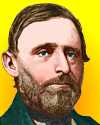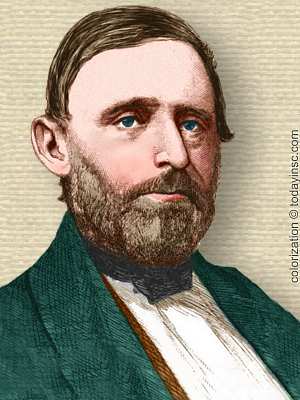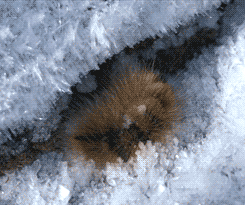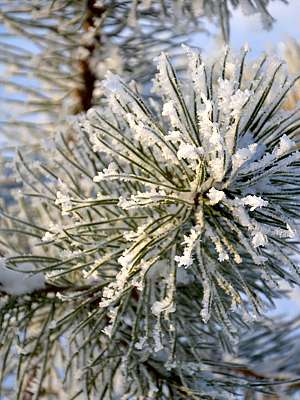 (source)
(source)
|
Karl Friedrich Mohr
(4 Nov 1806 - 28 Sep 1879)
German analytical chemist and geologist who invented or improved a number of titration procedures.
|
FREEZING OF PLANTS AND ANIMALS.
Prof. FR. MOHR.
translated from the german, by j. fitzgerald, a.m.
from The Popular Science Monthly (May 1873)
[The reader is cautioned to regard the ideas in this article as speculations by Mohr — an early attempt at understanding — not as facts accepted now. Consider the article as only food for thought. In the interesting case of the arctic wooly bear caterpillar, present knowledge is that there is a natural antifreeze in its body. —Webmaster.]
[p.96] It is a fact, as yet unaccounted for, that, whereas the thawing-point of ice is constant, the freezing-point of water may, under certain conditions, be brought considerably below the temperature at which ice begins to melt. In glass vessels, with free access of air, pure water may be reduced to a temperature of from 15° to 17° Fahr. below the thawing-point, or, in a vacuum, from 18° to 20° Fahr. without freezing. A slight concussion, or contact with any rough surface, but especially with ice or snow, causes congelation at once, and the temperature ascends to the thawing-point. This rise of temperature is usually explained by the transition from the liquid to the solid form; but this is, after all, no true explanation, but merely a putting together of two facts which are apparently very nearly related.
[p.97] The greater fall of the freezing-point in vacuo, as compared with its fall in the atmosphere, would appear to be ascribable to the absence of small corpuscles (spores?). The melting of ice, as also the freezing of water, is a purely chemical process, though commonly called physical. Here heat is converted into a chemical effect; and, conversely, a chemical effect into heat. The phrase, “heat becomes latent,” can no longer satisfy us, for latent heat is no heat at all. Here centre some facts belonging to the organic kingdom, to which my attention has been called by a letter received from Herr Fr. Dönhoff, of Orsoy.
The humors of butterfly-pupæ, which pass the winter in the open air, remain fluid in the coldest climate. If we cut in two such pupæ, at a temperature of 15° to 13° Fahr., the two halves quickly congeal and become as hard as stone. Juices of plants which do not freeze during winter, remain fluid, as is shown by the flexibility of the cabbage-leaf; while wet frozen linen may be broken, but refuses to bend. If you crush the leaves of green or red cabbage at a temperature below the freezing-point, they freeze at once; and, if you cut in pieces the ribs of a cabbage-leaf, you cannot press water out of the ends, for it freezes the moment they are cut up. Here the question arises how it is that watery fluids remain liquid in the tissues of animals and plants, whereas they at once freeze when the tissues are injured. A constant supply of heat is not to be thought of in pupæ or in eggs, such as is found in animals. Here I will bring forward two facts which throw some degree of light upon this question.
If you throw upon a glass plate a thin layer of flower of sulphur, and melt it by the application of heat, you will find that the larger particles are the first to become dry and solid on cooling, and to assume the yellow color. The smaller particles, on the other hand, remain fluid at common temperatures. Under the microscope they are transparent, and may be spread out with the dry finger; a fact which proves them to be viscous. Hence it follows that minute particles of sulphur may be cooled 170° below their melting-point without solidifying, but not so with larger particles.
Once, in preparing phosphuretted hydrogen, I suffered the mixture of phosphorus and caustic alkali to cool in the retort. On taking the apparatus apart on the next day, the phosphorus was found to be still molten at a common temperature, though its melting temperature is 115° Fahr. On repeating the experiment, it was found that the phosphorus might be cooled to 38° Fahr. before it solidified. Thus it remained fluid 77° below its melting-point.
Another observation was made, as follows: One night, at ten, o’clock, with the temperature at 4 Fahr., a dense fog lay over, the Moselle, through which, however, the brighter stars were visible. A cold current of air was coming from the direction of a neighboring hill, some 350 feet in height. The mist advanced steadily from the hill over the valley, but was constantly renewed, as the cold blast [p.98] came in contact with the moist air over the stream. The following morning all the trees, especially the pines, were covered with a heavy-hoar-frost, but on the land-side only, not on the water-side. On examining the ice-spicules, they were found to be perfectly crystalline, with angles of from 60° to 120°, and the long needles were made up of minute crystals set one upon another, and on one side resembling a flight of stairs. The particles of water floating in the air were, of course, of the temperature of the atmosphere, and consequently below the thawing-point. So soon as they came in contact with the points of the ice-spicules, they solidified, just as very cold water will when it is touched with ice. If the particles of mist had been changed into ice while still floating in air, they would have gathered upon the spicules of the pines in the shape of irregular pulverulent conglomerates, but would not have formed crystals. The plainly crystalline form of the ice-spicules shows, beyond a doubt, that the particles of mist were fluid at 4° Fahr. From these facts it follows that the minuter the particles of a liquid body are, the further they can be brought beneath their thawing-point without freezing.
If, now, we make an application of these facts to the above phenomena of organic Nature, we find that the reason why watery humors of pupæ, eggs, leaves and shoots, do not freeze, is because the cells containing these humors are very minute: in other words, the larger the cells the more quickly will plants freeze. It is well known that the young sprouts of vines, potatoes, and other plants, very readily freeze under a light frost, as was the case on May 12th of last year. Now, these young sprouts of vines are extremely juicy, containing a great quantity of water, and consequently but little cellulose. And, although the vines of the preceding year stood a winter temperature of 2° Fahr. without freezing, the sprouts of the self-same plants were frosted at 21° Fahr. Freezing expands the water and bursts the cells, and the break-up of the texture stops the process of growth. The buds of vines are more watery than the ligneous vines themselves. Hence, too, last winter, on the night of December 7th, many buds were frozen, while the vines were unhurt. On a vine eight feet in length, one of the latest of the buds rested on a wall covered with snow, and this shot forth in the spring, though all the other buds on the vine failed. It was the coming of the frost so early in December that made it so destructive, for the vines grow ever drier, and the sap tends toward the roots, from the beginning of autumn. This process had not gone so far in December as it would have gone in the first half of January, when usually the heavy frosts set in. Those branches whose buds are destroyed by frost, afterward die of their own accord, because the sap is unemployed, and the work of the leaf has ceased. Several of the vines remained green, and flourished toward the end of April on being pruned, but afterward dried up, as their buds were without life.
[p.99] Hence we might draw the general conclusion, that all southern plants which are unable to endure our winter have large cells, and that, at the North, only such plants can be naturalized as answer to the requirement of small cells. As in Nature there are no aims, but only necessity, we may also hence conclude that a low temperature is favorable to the development of small cells. We have here, furthermore, an explanation of the hairy coats of animals. Animals which live in the North have all a thick coat, while those living in the south have a thin one. The mammoth was covered with hair 12 inches long, while his descendant, the elephant, who lives only in southern climates, is almost naked. Animals coming from the south, and acclimatized in the north, acquire hair, and vice versa. At the poles the fox wears his winter-coat the whole year through. In Sweden his coat remains for 10 months; in Germany, for 6 months; farther south, 3 months—until at last it is entirely dropped. No one will here discover an aim, but rather this necessary consequence, that a lower temperature produces a growth of hair in some way unknown to us. The same is true as to the development of cells. If, as a general rule, a warmer temperature necessitates larger cells, then the plants of southern regions will perish from the frost of northerly latitudes. The leaf of the potato-vine can never endure frost; but it is only in early spring that the plant can be visited by frost in temperate climates, and there is no frost in summer, while in autumn the tubers are protected by the soil. The young branches of the oak and beech (two trees belonging, indeed, to our climate) are quite as little able to endure the frost, and suffer from it severely during the night in spring. On the other hand, the spicules of the pine and the sword-shaped leaves of the yucca stand the severest cold of our winters.
As regards the temperature of those portions of plants (sprouts of vines, potatoes, etc.) which are killed by the spring frosts, we have no definite knowledge. It is probable that these parts become, by radiation, considerably colder than the shining bulb of the thermometer, and that they do not share in the temperature of the air, but fall to a lower temperature by radiation. In cloudy nights, when the thermometer shows 30° or 31° Fahr., nothing freezes, though the contrary takes place on bright nights. But here, too, the smallness of the cells appears to lower the freezing-point of water some few degrees.
Yet, in thus bringing into very probable relation two different facts, viz., the non-congelation of pupæ and leaves, and the fluidity of molten sulphur and of mist-particles, we have no complete explanation of the phenomenon. Such an explanation would show why it is that small particles have a different freezing-point from large ones of the same substance. This would require a very profound acquaintance with the nature of the molecular motion of heat, as also of chemical affinity.—Gaea.
- 4 Nov - short biography, births, deaths and events on date of Mohr's birth.
- Karl Friedrich Mohr - Short biography, from 'Sketch of Friedrich Mohr', Popular Science Monthly (1880)







